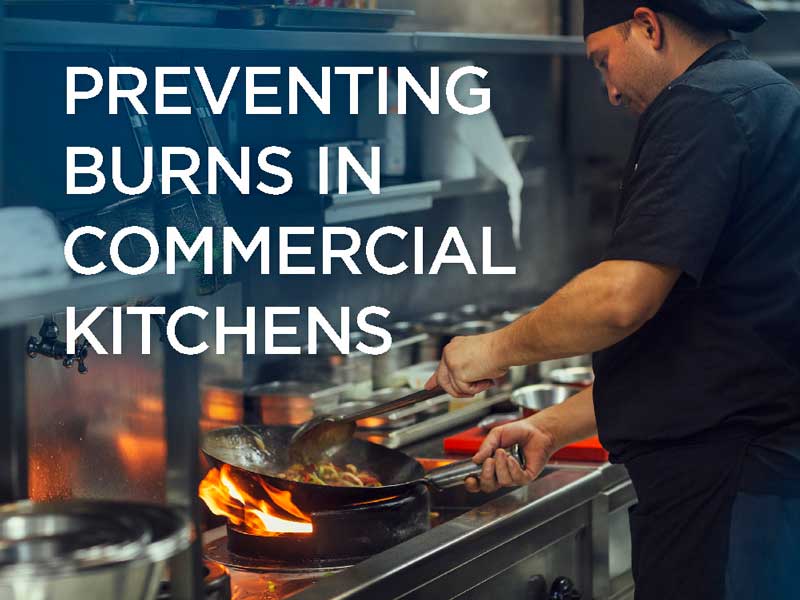- Home
- Loss Control
- Loss Control Insights
- Preventing Burns in Commercial Kitchens
“Commercial kitchens, no matter how well managed they are, can be a recipe for disaster when it comes to the potential for burns,” says EMC Program Development Engineer Neil Wysocki.
Think about it: Kitchens are often full of hazards such as large quantities of hot cooking oil, boiling liquids on the stove, ovens, hot grills and griddles splattering grease, and large numbers of servers and chefs milling around the confined area. Unless the area is managed carefully, someone is likely to get injured.
Neil says it’s wise to be concerned about burns because it’s a real problem in the food service industry. “The American Burn Association says that food service workers experience the highest number of burns of any employees, about 12,000 each year,” he says.
In terms of worker’s compensation costs, the National Safety Council lists burns as second only to motor vehicle accidents, with an average cost of $49,107 per accident (2015-2016 data). Slips and falls are the third most costly workers’ compensation injuries, at an average of $46,297 in those same years. Preventing slips and falls may decrease the number of burns, and preventing burns may decrease the number of slips and falls in your establishment.
Neil makes these observations about preventing burns in your kitchen:
- Remind workers frequently about kitchen dangers. Neil says it’s easy to get complacent when performing the same tasks day after day. In the rush of getting food cooked and out to diners, it’s easy to forget how hot the fryers, ovens, griddles and cookstove really are. Planning routes for traffic flow can also prevent workers from colliding with each other.
- Keep an eye on your safety records and note where and how injuries and near-misses occur. This will point you toward any equipment to replace or upgrade, as well as safety programs to better train workers in areas where burns are most likely to occur.
- Keep your work areas cleaned up. Water, and especially grease, can cause slips and trips leading to even more spilled liquid. This brief video clip shows the dangers of not keeping floors clean. In addition, ensure that oily rags are not left out. Instead, they should be immediately disposed of or stored in a sealed metal container and disposed of daily. Keep towels and aprons away from flames, and don’t use equipment that smokes or sparks.
- Whenever possible, large containers of hot liquids should be cooled to a safe temperature before being moved to another area.
- Take special care with your deep fat fryers; they are a huge risk for splatters and burns.
- Know how to deal with grease fires safely by turning off the heat source, covering the fire with a lid or using a Class K dry chemical fire extinguisher.
- Manage stovetop work carefully by avoiding overcrowding on the burners, lifting lids slowly to allow steam to escape, keeping burner flames turned down so flames cover only the bottom of the pan (no shooting flames around the pan) and keeping pot handles turned in so they can’t be bumped by someone walking by the stove.
- Make sure employees have the personal protective equipment (PPE) necessary for the tasks they perform and to fit the dangers present in your kitchen. “PPE is the low-hanging fruit and one of the easiest ways to prevent burns,” Neil says. And while you’ll also have to ensure your equipment, procedures, cleaning and training offer safety to workers, PPE can be their last line of defense against serious burns. Non-skid shoes or boots help prevent slips with that large kettle of hot soup and burns if a hot object lands on a foot. In addition, require well-padded gloves for pulling hot pans out of the oven; heavy, long-sleeve shirts and long pants; splatter guards; and gauntlets for protection from grease splatters.
Making Deep Fryers Safer
Because it’s unlikely that commercial kitchens will eliminate a need for fryers anytime soon, Neil suggests making yours as safe as possible by upgrading your old system with these features:
- Splatter guards large enough to keep splatters away from workers and from adjacent work areas and the floor
- An auto basket system that raises and lowers the basket automatically, allowing employees to stand further away
- Automated features, such as internal filtration and pumps and integral systems for draining and refilling
- A strong exhaust system to get fumes out of the kitchen as quickly as possible
- A built-in grease disposal system that prevents workers from handling hot oil and carrying grease to a disposal site. “Carrying large containers of hot grease is probably the most dangerous task in most kitchens,” says Neil. If you can’t automate this task, at least use a cart to haul the oil to the disposal site
Get in touch
Need help? We’re here for you! Whether you have questions or need personalized assistance, your local office is ready to support you.
Loss Control Insights
Stay informed with the latest news and receive actionable safety tips, all carefully curated by our team of experts.
